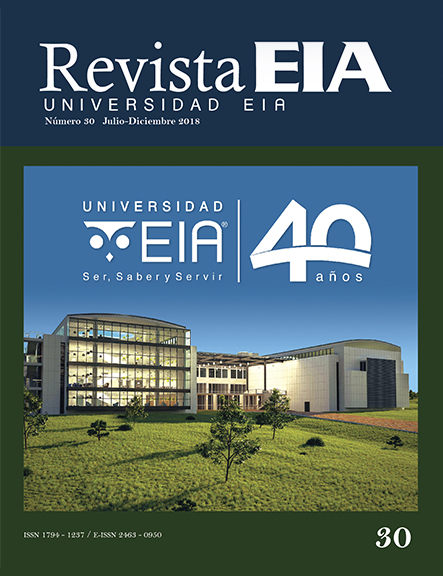Brecha digital e inclusión digital: fenómenos socio – tecnológicos
Brecha digital e inclusión digital: fenómenos socio – tecnológicos

Copyright statement
The authors exclusively assign to the Universidad EIA, with the power to assign to third parties, all the exploitation rights that derive from the works that are accepted for publication in the Revista EIA, as well as in any product derived from it and, in in particular, those of reproduction, distribution, public communication (including interactive making available) and transformation (including adaptation, modification and, where appropriate, translation), for all types of exploitation (by way of example and not limitation : in paper, electronic, online, computer or audiovisual format, as well as in any other format, even for promotional or advertising purposes and / or for the production of derivative products), for a worldwide territorial scope and for the entire duration of the rights provided for in the current published text of the Intellectual Property Law. This assignment will be made by the authors without the right to any type of remuneration or compensation.
Consequently, the author may not publish or disseminate the works that are selected for publication in the Revista EIA, neither totally nor partially, nor authorize their publication to third parties, without the prior express authorization, requested and granted in writing, from the Univeridad EIA.
Show authors biography
Existe una diferencia entre comunidades respecto al acceso y uso de herramientas tecnológicas para satisfacer necesidades y mejorar condiciones de vida; fenómeno definido como brecha digital. Para reducir dicha diferencia se emprenden propuestas y procesos en el marco del fenómeno denominado inclusión digital.
Se ha identificado que estos dos fenómenos integran aspectos sociales y tecnológicos que deben ser considerados al momento de implementar los programas y proyectos.
Adicionalmente, se considera que la Administración de Sistemas Informáticos es un área disciplinar que integra conocimientos necesarios para estudiar dichos fenómenos. La administración es una disciplina de las ciencias sociales y los sistemas informáticos son productos que se desarrollan en el marco de las ciencias exactas.
En el presente documento se plantea la relación entre la Administración de Sistemas Informáticos y el estudio (análisis, mejora, diseño y propuesta) de los fenómenos de la brecha e inclusión digital.
Article visits 2067 | PDF visits 905
Downloads
- Aguntín Lacruz, M. d. C. & Clavero Galofré, M., 2009. Indicadores Sociales de Inclusión Digital: Brecha y Particiáción Ciudadana. Derecho, gobernanza y tecnologías de la información en la sociedad del conocimiento, pp. 143-165.
- Association for Computing Machinery (ACM); Association for Information Systems (AIS), 2010. ‘IS 2010. Curriculum Guidelines for Undergraduate Degree Programs in Information Systems’. s.l.:s.n.
- Brandtzaeg, P. B., Heim, J., & Karahasanovic, A. (2011).
- Understanding the new digital divide-A typology of Internet users in Europe. INTERNATIONAL JOURNAL OF HUMAN-COMPUTER STUDIES, 69(3), 123–138. http://doi.org/10.1016/j.ijhcs.2010.11.004.
- Caruso, S., 2014. Creating Digital Communities: A resource to Digital Inclusion. New York: Nova Science Publishers.
- Gonzáles Zabala, M. P. & Sánchez Torres, J. M., 2013. Análisis de las estrategias del Gobierno colombiano para la inclusión de los ciudadanos en la Sociedad de la Información propuestas desde 2000 hasta 2011. Revista de Estudios Sociales, pp. 133-146.
- López López, P., 2009. Inclusión Digital: Un Nuevo Derecho Humano. Educación y Biblioteca, pp. 114-118.
- Martínez Cantos, J. L., 2013. La persistencia de la brecha digital de género: Análisis cuantitativo de España y Europa. Madrid: Universidad Complutense de Madrid.
- Sepúlveda López, J. J., & Ramírez Castañeda, L. A. (2015). Digital inclusion and social perspective - Critical discussion based on a systematic review of the literature. In R. L. Isaias P. (Ed.), Proceedings of the 14th International Conference WWW/Internet 2015 (pp. 209–212). IADIS. Retrieved from https://www.scopus.com/inward/record.uri?eid=2-s2.0-84958529386&partnerID=40&md5=be33c2e9ef7774c81018e07821e364d8.
- The Association for Computing Machinery (ACM); The Association for Information Systems (AIS); The Computer Society (IEEE-CS), 2005. Computing Curricula 2005. The Overview Report, Covering undergraduate degree programs in Computer Engineering, Computer Science, Information Systems, Information Technology, Software Engineering’. Estados Unidos de América: IEEE Computer Society.
- Thompson, K. y otros, 2014. Digital Literacy and Digital Inclusion - Information Policy and the Public Library. s.l.:Rowman & Littkefield.
- Tien, F. F. ., & Fu, T.-T. . c. (2008). The correlates of the digital divide and their impact on college student learning. Computers and Education, 50(1), 421–436. http://doi.org/10.1016/j.compedu.2006.07.005.
- Universidad Nacional de Colombia, 2017. ADMINISTRACIÓN DE SISTEMAS INFORMÁTICOS. [En línea] Available at: http://www.manizales.unal.edu.co/menu/programas-academicos/carreras/administracion-de-sistemas-informaticos/




